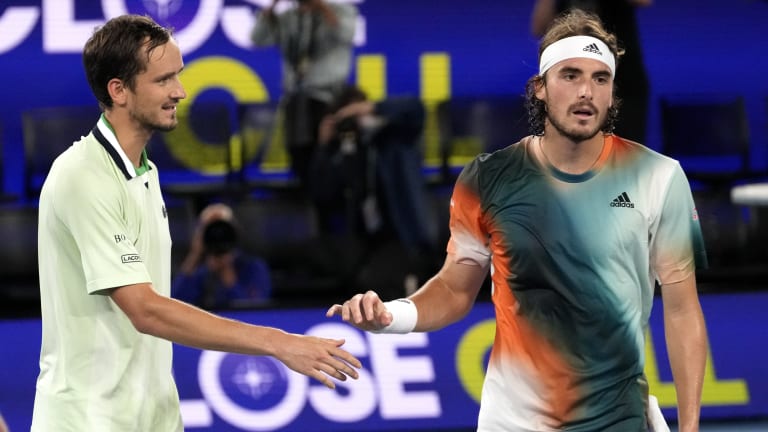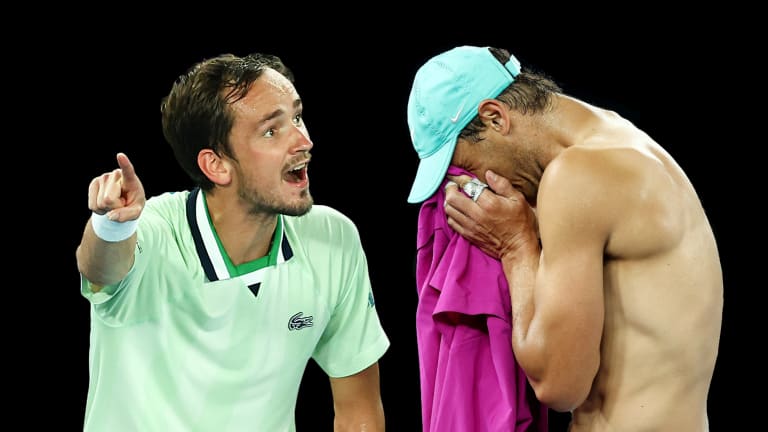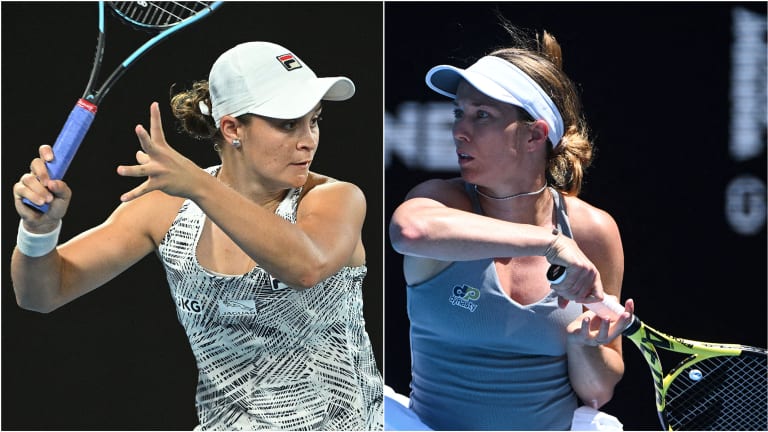Australian Open
The Rally, Australian Open Edition: Reviewing semifinal fireworks, and looking ahead to the men's and women's finals
By Joel Drucker and Steve Tignor Jan 28, 2022Australian Open
Australia at Last: Reflections on a first trip to the AO
By Jon Levey Jan 29, 2025Australian Open
Alexander Zverev must elevate his game when it most counts—and keep it there
By Peter Bodo Jan 27, 2025Australian Open
Jannik Sinner draws Novak Djokovic comparisons from Alexander Zverev after Australian Open final
By Steve Tignor Jan 26, 2025Australian Open
Alexander Zverev left to say "I'm just not good enough" as Jannik Sinner retains Australian Open title
By Matt Fitzgerald Jan 26, 2025Australian Open
Jannik Sinner is now 3-0 in Grand Slam finals after winning second Australian Open title
By TENNIS.com Jan 26, 2025Australian Open
Taylor Townsend and Katerina Siniakova win second women's doubles major together at the Australian Open
By Associated Press Jan 26, 2025Australian Open
Madison Keys wins her first Grand Slam title at Australian Open by caring a little bit less
By Steve Tignor Jan 25, 2025Australian Open
Henry Patten, Harri Heliovaara shrug off contentious first set to win Australian Open doubles title
By Associated Press Jan 25, 2025Australian Open
Aryna Sabalenka takes a rare loss in Australian Open slugfest
By Pete Bodo Jan 25, 2025Australian Open
The Rally, Australian Open Edition: Reviewing semifinal fireworks, and looking ahead to the men's and women's finals
An exchange of verbal volleys, as we near the conclusion of the season's first Slam.
Published Jan 28, 2022
Advertising
INTERVIEW: Rafael Nadal advances to the final, where he'll play for his 21st Grand Slam title
Hi Steve,
One aspect of this year’s Australian Open that’s most excited me is to see the blossoming of a wide range of playing styles. The enduring excellence of Roger Federer, Rafael Nadal, Novak Djokovic and Serena Williams posed one question after another. And if players wanted to answer those questions, they’d have to create arsenals that were not just proficient, but distinctive and highly imposing.
In the men’s field, it’s interesting to note that the shortest semifinalist was Nadal (6’1”). The other three stand at least three inches taller, from Stefanos Tsitsipas at 6’4”, to 6’5” Matteo Berrettini and 6’6” Daniil Medvedev. Time was when a tennis player 6’3” or taller largely revealed little more than a big serve and wingspan. Groundstrokes? Are you kidding? Speed? Why run when you can reach? But that’s all changed. Tsitsipas, Berrettini and Medvedev each represent a new paradigm: a big server who can crack powerful groundstrokes, cover the court quite well and instill all kind of doubt in opponents with their wide range of weapons.
But as Nadal showed in the first semi, doubt is not always necessary; sometimes the best weapon is knowledge and execution. The entire planet knew that the plan was for Nadal to use his crosscourt forehand to expose Berrettini’s much weaker backhand. Berrettini’s challenge was to keep enough backhands in play and also run around them often enough to smack plenty of forehands. My thinking was that after losing to Nadal in straight sets in their only prior match (the semis of the 2019 US Open), Berrettini would make it much more competitive this time—particularly from the start. Instead, Berrettini was sluggish and Nadal, likely aided by having two days off after his five-set quarterfinal versus Denis Shapovalov, was razor-sharp. At last, Berrettini woke up, taking the third set and keeping it tight in the fourth. It wasn’t enough, Nadal in the end revealing that Berrettini has more work to do if he’s to win major titles.
What an amazing month this has been. When it began, Nadal was recovering from COVID-19 and Novak Djokovic was a heavy favorite to win a record-breaking 21st major. Nadal is now in the finals here for the sixth time, 13 years after his first Australian Open final. It’s remarkable to think that Nadal is a better player than he was then. It’s even more pleasing to see that Nadal is healthier at this stage of the tournament than he has been in many years.
Steve, what did you make of the Medvedev-Tsitsipas semi?
Advertising

If you were wondering whether these two old not-friends might have buried their hatchets, you can forget about that now.
© AP
Hi Joel,
One thing is now clear after the Medvedev-Tsitsipas semifinal. If you were wondering whether these two old not-friends might have buried their hatchets, you can forget about that now. Medvedev spent a good portion of this match screaming at the chair umpire, trying to get him to slap Tsitsipas with a code violation for coaching. Finally, the umpire did—apparently, a Greek-speaking official overheard what Tsitsipas’ father, Stefanos, was saying to him from the player box. After that, Tsitsipas didn’t win another game. When the match was over, Tsitsipas could barely stand to look at Medvedev as he gave him a drive-by handshake at the net.
So while most of the U.S. was sleeping, there were some fireworks Down Under. From a playing perspective, I thought the two semifinals were similar. In each case, the first set gave the winner an edge that the loser could never surmount, no matter how hard he labored to change the momentum. As you said, we knew Nadal would go after Berrettini’s backhand, but it didn’t look like the Italian was ready for the force and persistence of that lefty barrage; Rafa was sharp from the start, and determined to play the points on his terms. With Medvedev, the key was how clutch he was in the first-set tiebreaker. Tsitsipas led 4-1, and 5-4, but Medvedev cleaned the lines with his serve, and came up with two remarkable baseline winners—a forehand pass and a backhand into the corner—when he had to have them. That five-minute swing put him into the final.
You mention the evolution of the tall player who can hit ground strokes. Medvedev and Nadal, the two men’s finalists, are good examples of the way the ATP game has developed. Rafa isn’t especially tall, but like Medvedev, he wins with a deadly combination of serving and rallying. Yes, Berrettini had 14 aces to Rafa’s five, but Rafa was broken just once; he won a higher percentage of his first- and second-serve points; and when it came time to serve out the first and fourth sets, he was flawless. Medvedev’s serve was even better: 13 aces, 86 percent of first-serve points won, 72 percent of second serve points won. It’s not enough just to serve well or to grind forever these days; you need to do both.
It’s hard to think of a better outcome, and better final, for the men’s draw. Aussie officials were desperate to have Djokovic come and try to win No. 21, but Rafa has filled in brilliantly. And Medvedev will try to back up his first major win with another. I had no idea that had never been done on the men’s side in the Open era.
Joel, what are your thoughts on the men’s final? Djokovic’s departure seems like a long time ago, doesn’t it?
Advertising

Nadal leads the head-to-head against Medvedev, 3-1, and he won their biggest match, at the US Open in 2019. That one was close, and two of their other meetings were as well.
Steve,
Indeed, the Djokovic controversy in time receded and the tennis itself became the big story—at least for those of us who pay close attention to the sport. Of course, Djokovic’s pandemic era journey is far from over, as throughout 2022, he will continue to make his way around the world and grapple with various protocols. But that’s another story for another time.
The Medvedev-Nadal final has so many compelling plot lines. There’s the generational tussle. There’s history—Medvedev seeking a second straight major (and, sometime in February, the chance to become No. 1). There's, of course, Nadal’s pursuit of that 2lst major.
Just over two years ago, Nadal barely beat Medvedev in the 2019 US Open final, 7-5, 6-3, 5-7, 4-6, 6-4. That was Medvedev’s first Grand Slam final. This one in Australia will be his fourth. On momentum alone, much looks promising for Medvedev.
As far as the battle between the lines goes, the pet pattern Nadal ran versus Berrettini—crosscourt forehand to the backhand—goes directly into Medvedev’s superb two-hander. How will Medvedev aim his two-hander? Will Nadal instead hit more down-the-line forehands?
Then there’s the return of serve, a shot each player hits exceptionally far behind the baseline. Will either seek to disrupt that with wider serves, particularly Nadal in the ad court and Medvedev in the deuce? Here too, Medvedev has the bigger and, theoretically, more versatile delivery.
I’m also curious to see if either man makes his way into the net, not an easy play given how well each of these guys moves and hits passing shots.
So while the logic of skills, patterns and court geography give an edge to Medvedev, this match might also be decided by various X factors: nerves, innovative tactics, raw willpower, even luck. In all of these areas, Nadal has proven himself a master for many years. And here we now have Medvedev, an ascending genius.
What intrigues you about this match-up, Steve?
Advertising
This might be the first time that a member of the Big Three hasn’t been the definitive favorite in a major final against a non-member of the Big Three.
Joel,
The contrasts are intriguing. 35 vs. 25. Big Three vs. Next Gen. Spaniard vs. Russian. Lefty vs. righty. Heavy topspin vs. tricky flat ground strokes. Clay-courter vs. hard-courter. Earnest vs. sardonic. Twenty-one vs. back-to-back.
We know all about Nadal vs. Djokovic, and we’ve gotten to know about Djokovic vs. Medvedev over the last few years. But Nadal vs. Medvedev feels like two different tennis universes colliding. And neither would seem to have a definite edge to start. This might be the first time that a member of the Big Three hasn’t been the definitive favorite in a major final against a non-member of the Big Three.
Nadal leads their head-to-head 3-1, and like you said he won their biggest match, at the US Open in 2019. That one was close, and two of their other meetings were as well. It’s probably good news for Medvedev that he snuck one win in there, just so he knows he can do it. And also like you said, I think the intangibles, the mental aspects of the match-up, will play a big role. If Nadal gets a lead and sees No. 21 up ahead, will he be able to calm his nerves? He almost gave away that 2019 US Open final from two sets up. And how might Medvedev react if he gets down early? He has a tendency to blow a fuse in those situations, and he doesn’t have many epic comebacks to his name. But he did beat Felix Auger-Aliassime from two sets down this week.
First, though, we have a compelling women’s final to watch. Does this feel like coronation time for Ash Barty? She’s No. 1, she has Wimbledon and Roland Garros titles, and she hasn’t dropped a set, or even come close to dropping a set, in her first six matches. It would seem to be time for her to bring the Aussie Open title back home for the first time in 40-odd years. She has made it all look so easy so far, and no one seems to have an answer for her backhand slice-forehand drive combination. Barty has yet to face anyone in the Top 20, of course, but she won’t face a Top 20 opponent in the final, either.
What have you thought of the women’s draw, and what are you looking forward to in the final, Joel?
Advertising

For the second year in a row, the championship will come down to the tour's hottest player and a surging former collegiate star.
Steve,
Persistence and eloquence are the words that best define my experience of the 2022 Australian Open women’s tournament.
It was gratifying to see the resurgence of two terrific Americans, Amanda Anisimova and Madison Keys. Each has struggled in recent years, but in Melbourne, these two took major steps forward.
Anisimova first gave a positive indication in the second round when she beat 22nd-seeded Belinda Bencic. In her next match, Anisimova was even more impressive, playing a gem of a third-set tiebreaker to beat defending champion Naomi Osaka. Though she lost in the round of 16 to Barty, Anisimova has regained the bounce and positive focus that put her on the tennis radar three years ago. Hopefully, that will continue.
Keys’ run to semis included a first round win over 2020 Aussie titlist Sofia Kenin, a third-set tiebreaker victory versus Wang Qiang (who previously upset Coco Gauff) and dominant efforts versus Top 10 newcomer Paula Badosa and reigning Roland Garros champion Barbora Krejcikova. Keys also spoke with a fresh form of awareness and optimism.
How great it was to see Naomi Osaka return to competition and speak so thoughtfully about her journey. “For me, I feel like I grew a lot in this match,” she said after losing to Anisimova. “The last match that I played in New York, I think I had a completely different attitude, so I’m really happy, of course I lost, but I'm happy with how it went.”
Then there was Alizé Cornet’s first trip to a Slam quarterfinal on her 63rd try. What a tribute to persistence and Cornet’s love of tennis. Along with that, I can’t help but savor Cornet’s confession that her pursuit of perfection was counterproductive. As Cornet wrote in her book, Transcendence: “Now that I have finally understood that I was chasing a chimera all this time, I’m giving in a little more and it feels good.”
Both finalists also have great appeal. Given how much joy Barty brings to tennis, let’s recall that she too went through her own self-inquiry phase, taking a sabbatical from the game for just over a year following the 2014 US Open. Barty returned and has emerged as an exemplary champion in everything from manner to playing style. I’m hoping parents, coaches and players can learn much from Barty in all of those departments. Please, let us see juniors learn how to hit and properly deploy a slice backhand.
Collins has her own brand of tenacity, battle-tested through years of hard work, a rare foray for an elite pro into college tennis and, most recently, major health challenges. What great tennis she’s played these last two weeks. Though Collins’ laser-like drives appear bold, they are at heart based on skill and practice: Collins is striking the shots she’s been trained to hit.
With Collins’ big weapons in mind, while Barty is the obvious favorite, she’s hardly a lock. I can see a scenario where Collins can continue to play powerful, imposing tennis, akin to the ways Mary Pierce and Jennifer Capriati won their Grand Slam titles. Though then, of course, there’s Barty, more composed than ever when competing at her homeland Slam.
How do you see the women’s final playing out, Steve?
Advertising

Always Playing: Pickleballtv
The 24-hour channel of America’s fastest growing sport now has an app.
Joel,
There’s a feeling of déjà vu around this women’s final, at least for me. Two other times at this event, I’ve wondered whether a hard-hitting U.S. player might be able to break down Barty’s defenses, and two other times Barty hasn’t let it happen. Will she do to Collins what she did to Anisimova and Keys?
Either way, I think Barty’s presence in the final is important. At the start of the tournament, I was disappointed that the two US Open finalists, Leylah Fernandez and Emma Raducanu, went out so quickly. I’m all for surprises and upsets and fresh faces, but I also think it helps if there’s a sense of continuity to the tour, players that everyone recognizes, players who grow in stature with multiple Slam titles, people whose stories we get to know, people whose defeats come as a shock. Barty is turning into one of those players.
You’re right that this women’s event offered the mix of persistence and eloquence that we’ve come to expect at Slams, especially from Keys, Anisimova and Cornet. It’s interesting to hear them talk in the language of mental health and self care now, the one pioneered by Osaka in recent years. I get the sense that for someone like Keys, while her happiness may start with how she’s doing on court, it doesn’t end there. She and others like Cornet and Osaka are trying not to let every victory and defeat define how they feel about themselves. Yes, Keys will have bad matches and disappointments ahead, but she talks as if she’s ready for that. That seems like a healthy trend in tennis.
And that’s another reason to like Barty as a representative for this sport and role model for other players. As you said, she has dealt with her own motivational struggles, but she had no trouble pulling the ripcord, leaving the tour, and doing what she needed to do to be happy. No wonder so many of the women look up to her.
Enjoy the finals, Joel.